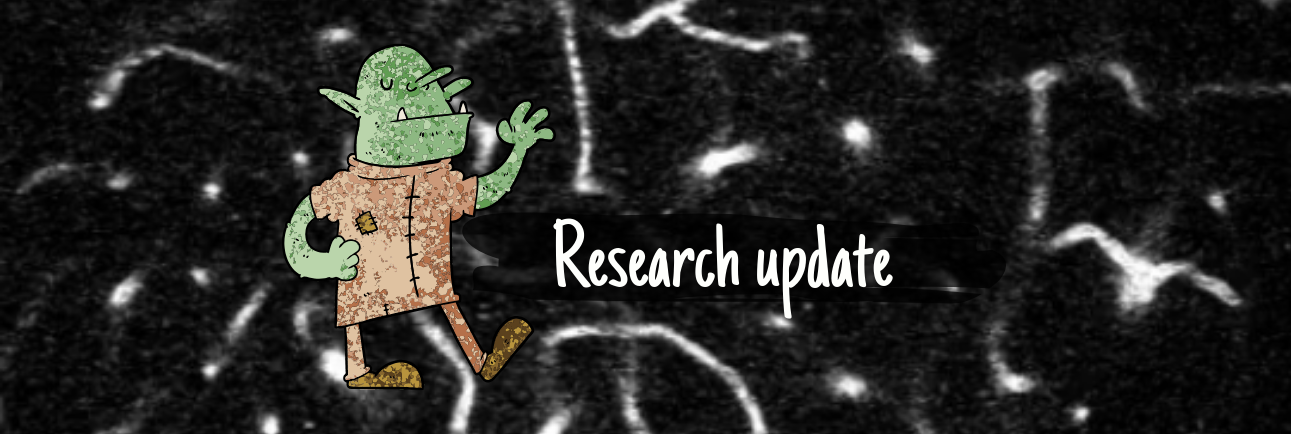Here comes the long overdue update on the research YOU are helping to achieve on Stall Catchers !
In short: we have just finished the "NOX" dataset -- the very first dataset looking into molecular mechanisms behind stall formation. Stall Catchers is now refilled with "Tau" data -- a dataset looking into one of the hallmarks of Alzheimer's disease, the Tau protein.
For more detailed science about the NOX and Tau datasets, see below...
The NOX dataset
The NOX dataset was the very first dataset checking a particular molecular pathway that may be involved in stall formation in Alzheimer's.
What does that mean? This great animation explains it well:
What was this research trying to achieve?
If we knew the precise molecular "steps" that lead to inflammation and stalled blood vessels in the brain and, in turn, Alzheimer's symptoms, we could find a way to target that process early enough to prevent it. The treatment could also be targeted enough and not "shooting in the dark", which could help minimize harmful effects to the organism.
For example, now we know that we can remove stalls by preventing neutrophils (white blood cells) from sticking to blood vessel walls. (See the newest publication about this research by our Cornell collaborators here.) But doing so with extreme immune therapy would most likely kill the organism! So the cure would be worse than the disease.
The NOX dataset was the first attempt to date to really understand the processes involved in stalled formation on a molecular level. Looking at upstream molecular pathways causing the inflammation that leads to stalls, aims to find ways to prevent the capillary stalling without directly blocking neutrophil adhesion (which has the potential for bad side effects).
How does this help find a treatment?
It doesn't directly, but pin-pointing the molecular pathway involved in stall formation could help identify drug targets. Drug targets could be specific molecules in the organism -- disabling or modifying them could help prevent or reverse stalls safely, and as such, reduce Alzheimer's symptoms. (See the video above for an easy visual explanation of this.)
There are many such inhibitor molecules already in development, mostly targeting diabetes and stroke. If we show this pathway is critical for the stalls (and we are using very targeted inhibitors to do this), these new drugs in development could be the next step towards selecting drug targets and looking for potential treatments.
What is "NOX"?
The particular molecule involved in the study was a NAPDH oxidase 2 (NOX2) inhibitor. Hence we dubbed it the "NOX" dataset :)
NAPDH oxidases are proteins in the cells that are involved in oxidative processes, such as reactive oxygen species (ROS) formation (translation: that almost always means "free radical formation"). In plain words, they have an important role in inflammation, which is suspected to attract white blood cells to capillaries and clog them.
NOX2 inhibitor targets a particular molecular pathway that could be involved in inflammation and stall formation. By giving this compound to mice and comparing the amount of stalls and Alzheimer's symptoms they experience to normal mice, the researchers were aiming to see if the suspected pathway is indeed involved in the formation of stalls.
What's the result?
Our part is now done -- we analyzed all the data from the mice involved in the study! Now we have to await the final verdict for the Cornell lab, who will look through the vessels that the crowd (you!) said might be stalled, and run statistical analysis to see if there is a real difference between the treated and the untreated mice.
Stay tuned to find out!!
And, as always, please ask your questions and discuss the science on our forum here.
The Tau dataset
In this study we are trying to see if stalls occur when there are Tau tangles induced genetically in mice. In humans with Alzheimer's disease we see both amyloid and Tau, but in mice they are induced separately and do not tend to co-occur. This gives us an opportunity to isolate potential stalling effects of Tau - in other words are there increased stalls with Tau aggregation just as there are with Amyloid aggregation?
The reason for looking at this is that lots of different protein aggregation seems implicated in various diseases: Huntington, ALS, Lewy Body dementia, etc. We are interested in studying how various protein aggregations may drive inflammation in the brain and blood vessels and could be contributing to symptoms of all these diseases, especially Alzheimer's.
On other news from the lab...
######Screening of FDA approved drugs Besides capillary stall analysis, our collaborators at Cornell are also using something called "blood flow measurement" for screening FDA approved drugs that could help improve blood flow in Alzheimer's mice. This method is faster than capillary analysis, but not as accurate.
The first screens of these drugs should begin this Fall/Winter. The drugs are mostly targeting leukocyte adhesion -- trying to prevent sticking of white blood cells to capillary walls. If any drugs looked promising, the next step would be to conduct capillary stall analysis.
So more exciting datasets might soon be coming to Stall Catchers!
ICYMI: Science of stalls reported for the first time in Nature Neuroscience
Find the full article here, and our "translation" here.



